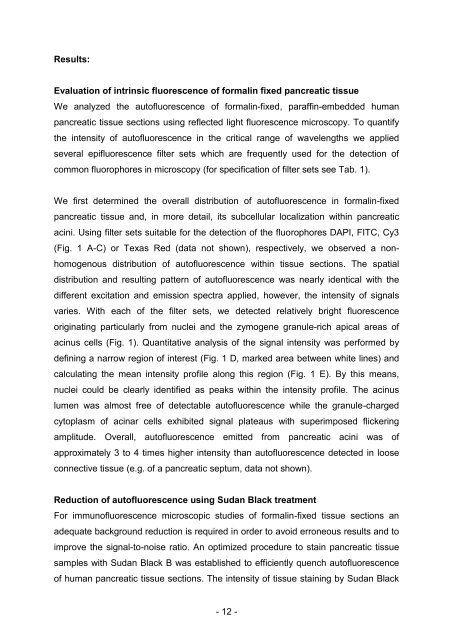Tierärztliche Hochschule Hannover - TiHo Bibliothek elib
Tierärztliche Hochschule Hannover - TiHo Bibliothek elib
Tierärztliche Hochschule Hannover - TiHo Bibliothek elib
Sie wollen auch ein ePaper? Erhöhen Sie die Reichweite Ihrer Titel.
YUMPU macht aus Druck-PDFs automatisch weboptimierte ePaper, die Google liebt.
Results:<br />
Evaluation of intrinsic fluorescence of formalin fixed pancreatic tissue<br />
We analyzed the autofluorescence of formalin-fixed, paraffin-embedded human<br />
pancreatic tissue sections using reflected light fluorescence microscopy. To quantify<br />
the intensity of autofluorescence in the critical range of wavelengths we applied<br />
several epifluorescence filter sets which are frequently used for the detection of<br />
common fluorophores in microscopy (for specification of filter sets see Tab. 1).<br />
We first determined the overall distribution of autofluorescence in formalin-fixed<br />
pancreatic tissue and, in more detail, its subcellular localization within pancreatic<br />
acini. Using filter sets suitable for the detection of the fluorophores DAPI, FITC, Cy3<br />
(Fig. 1 A-C) or Texas Red (data not shown), respectively, we observed a nonhomogenous<br />
distribution of autofluorescence within tissue sections. The spatial<br />
distribution and resulting pattern of autofluorescence was nearly identical with the<br />
different excitation and emission spectra applied, however, the intensity of signals<br />
varies. With each of the filter sets, we detected relatively bright fluorescence<br />
originating particularly from nuclei and the zymogene granule-rich apical areas of<br />
acinus cells (Fig. 1). Quantitative analysis of the signal intensity was performed by<br />
defining a narrow region of interest (Fig. 1 D, marked area between white lines) and<br />
calculating the mean intensity profile along this region (Fig. 1 E). By this means,<br />
nuclei could be clearly identified as peaks within the intensity profile. The acinus<br />
lumen was almost free of detectable autofluorescence while the granule-charged<br />
cytoplasm of acinar cells exhibited signal plateaus with superimposed flickering<br />
amplitude. Overall, autofluorescence emitted from pancreatic acini was of<br />
approximately 3 to 4 times higher intensity than autofluorescence detected in loose<br />
connective tissue (e.g. of a pancreatic septum, data not shown).<br />
Reduction of autofluorescence using Sudan Black treatment<br />
For immunofluorescence microscopic studies of formalin-fixed tissue sections an<br />
adequate background reduction is required in order to avoid erroneous results and to<br />
improve the signal-to-noise ratio. An optimized procedure to stain pancreatic tissue<br />
samples with Sudan Black B was established to efficiently quench autofluorescence<br />
of human pancreatic tissue sections. The intensity of tissue staining by Sudan Black<br />
- 12 -









![Tmnsudation.] - TiHo Bibliothek elib](https://img.yumpu.com/23369022/1/174x260/tmnsudation-tiho-bibliothek-elib.jpg?quality=85)






